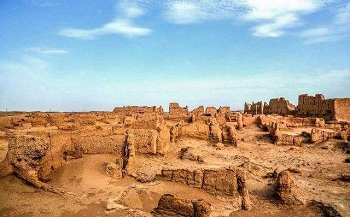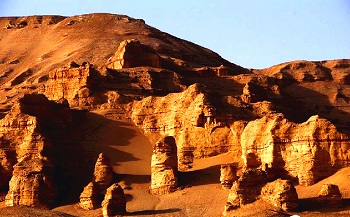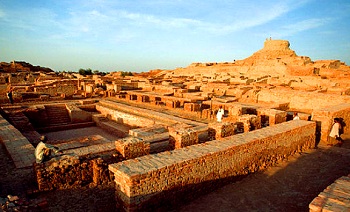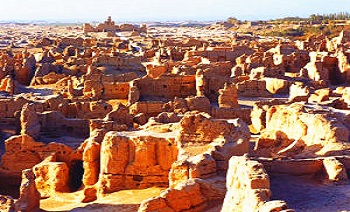The Loulan Site Situated on the western bank of the Lop Nor in the northeast part of Ruoqiang County is the Ruins of Loulan City, which is 1316 meters in Circumference, with rammed city walls. At northeast part of the city stands a stupa 10.4 meters high. In the southwest part there are many remnants of dwellings remained, in the middle of which stands a three-room construction. It faces due south to the southern city gate and may be government offices. The Loulan Kingdom was one of the 36 kingdoms in the Western Regions in the Western Han Dynasty, and the Loulan City was its political and economic center. The city was abandoned in the 4th century AD. The Loulan city was the first station for Han to come into the Western Regions in that time, and also was a hub of communication on the Silk Roads, Occupying a quite important geographical position. Now the Loulan Site is listed as a major cultural site under state protection.
The History of Loulan Site
The advantages geographical position brought about unparalleled prosperity to the ancient Loulan. The ancient Loulan City had a history of nourishing age and a brilliant oasis culture. But with the passage of time, the ancient Loulan City disappeared quietly after the long history in the 4th century. In 77BC, the Loulan Kingdom changed its name as Shanshan Kingdom, and selected Yuni as its capital. From the time of Eastern Han Dynasty to the times of Wei and Jing Dynasties, Loulan, continued to be an important communication juncture on the Silk Road for about 400 years. And it was about at the time of the Early Liang time, the city was deserted, thus it was buried in the desert for more than thousand years.


The Process of Discover Loulan Site
In February 1895, Sven Hedin, a Swedish, crossed the Taklimakan Desert along the Creya River to reach Lop Nur and carried out a hard but highly rewarding survey of geology, biology, and ancient cultural relics along the way. Overview of noteworthy ancient sites in the desert.
In September 1899, Sven Hedin began his second trip to the Taklamakan. The Central Asian expedition was funded by Swedish King Oscar and were sponsored by millionaire Emmanuel Nobel. Sven Heding stopped for a moment in the empty and cold Shexian County (now Ruoqiang) and then proceeded to the Lop Nur Desert at the eastern end of Taklamakan.
On March 29, 1900, a dramatic plot led to the discovery of this famous ancient site. When Heding and his team arrived at Lop Nur's north shore, they came to a place that seemed to be able to fetch fresh water. When they decided to dig a well into carrying water, they found that the only shovel was missing, and a guide accompanying him was sent back to the original road to look for it. Unexpectedly, the sandstorm was violent on the way, made this guide hungry, and unable to move forward. After the sand storm, tall mud towers and cascading houses suddenly appeared in front of the manual, and an ancient city miraculously revealed its face. The wizard reported on this finding. Sven Hedin came here immediately. When he found a few beautiful wood carvings from the site with his own hands, he was extremely excited and concluded that this was an important historical site. Heding later recalled: "How lucky is the shovel. Otherwise, I would never return to that place and realize this important discovery that seems to have a certain number, which will give the ancient history of central Asia a new and unexpected light!"
In March 1901, Sven Hedin started to excavate the ancient city. He couldn't wait to give out a reward. If anyone could find any form of human characters first, there would be rewards. Small pieces of feeling, red cloth, brown braids, coins, and pottery were unearthed at the excavation site. With the continuous development of excavations, a large number of Chinese texts, wooden textbooks of Lulu language, paper documents, and some Su special instruments, as well as exquisite silk and woolen fabrics, and unique wood carving ornaments were unearthed. For a whole week, in addition to excavations, Sven Hedin also investigated the temple sites and residential sites in the ancient city. He found that the word "Kroraina" appeared many times on the Lu Wenmu Bamboo Slips unearthed in the old town. According to the Chinese script found on the site, the city was called Loulan.


The investigation of Loulan Site
Between 1979 and 1981, the archaeological Institute cademy of Xinjiang Academy of Social Sciences and Chinese Academy of Sciences each organized three surveys and excavation of the ancient Loulan City and the banks of the Konqi River. The relics show that the geographical surroundings of the ancient Loulan City were Superb. It was on a table land between two rivers with a canal obliquely passing through the city.
In the vicinity of the ancient city, there were sites of houses, Buddist Pagoda, beacons, ancient tombs, etc. The dried female corpse found there was called “Loulan beauty...caused a sensation at home and abroad”.
At present, it is quite costy to get the permission to visit Loulan. The application is very complicated. we have to apply with much documents 1 years in prior. But if you are very interested in history of Silk Road and Ancient Civilization of ancient China. This is the place you will have to visit in your life!



